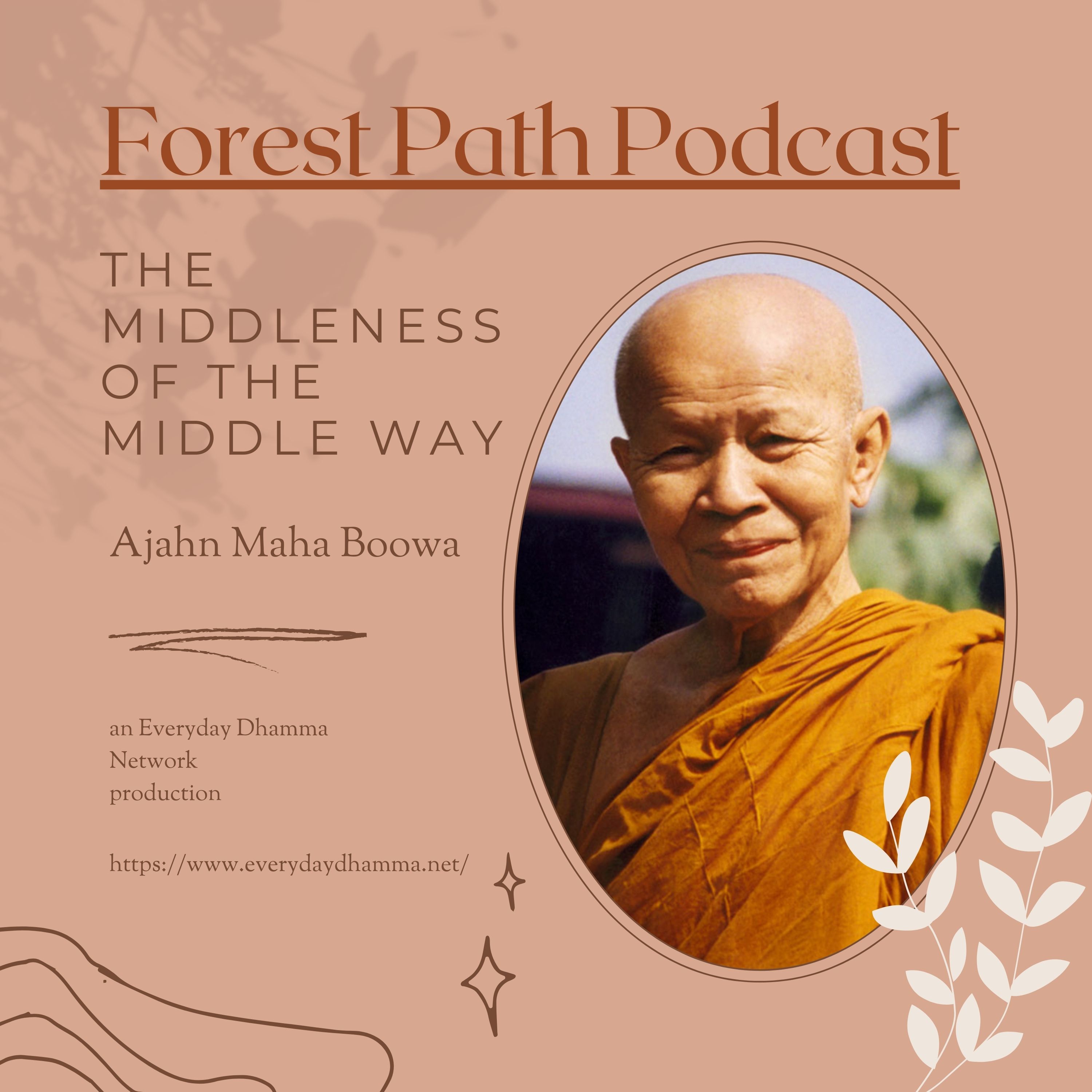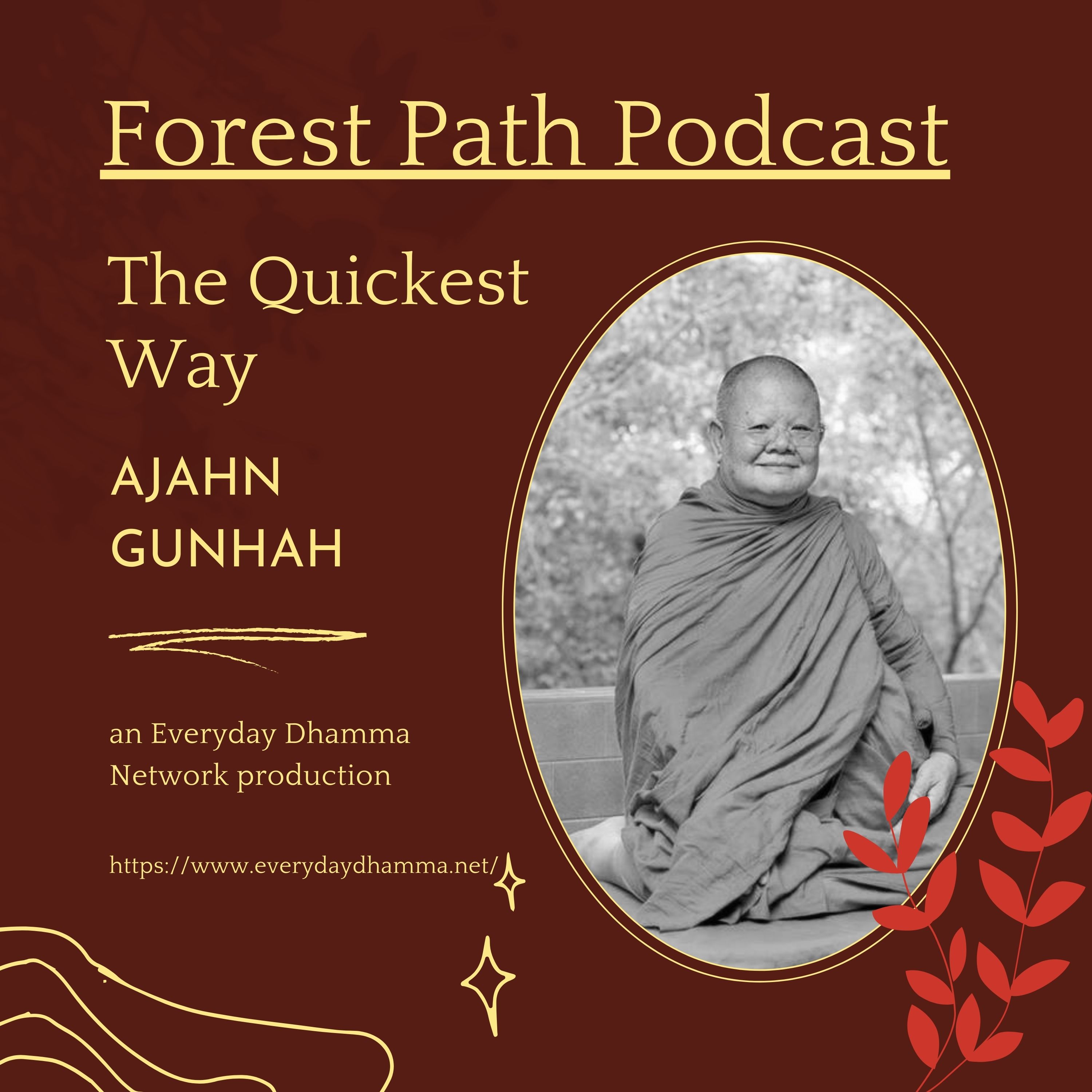Episode Transcript
The Middleness Of The Middle Way
by Ajahn Maha Boowa
I can tell a resolute person when I see him – like the Venerable Ajaan Mun. It was intimidating just to look at him. How could mental defilements not be intimidated by him? Even we monks were intimidated by him, and the defilements are smarter than we are, so how could they not be intimidated? They had to be intimidated. That’s the way things have to be. A teacher who possesses the Dhamma, who possesses virtue, has to be resolute so as to eliminate evil. He must be really resolute. The stronger the evil, the more resolute and strong his goodness has to be. It can’t afford not to be resolute and strong. Otherwise, goodness will lose out.
Suppose this place is dirty: However dirty it may be, we can’t clean it just by splashing it with a glass of water, can we? We’d have to use a lot of water to make it clean. If this place were filled with a pile of excrement, we’d have to splash it with a whole bucket of water. And not just an ordinary bucket – a great big one. A mighty splash, and all the excrement would be scattered. The place would become clean because the water was stronger. Being resolute means being earnest toward everything of every sort within the bounds of reason. Take this and think it over. If you act weakly when training yourself, you’re not on the path. You have to be strong in fighting with the mind’s defilements. Don’t let the strong defilements step all over you. If we don’t have any way of fighting defilements – if we’re weak and irresolute – we’re not good for much at all.
For those who want what is clean and good from the Dhamma: What is the Dhamma like? What did the Buddha teach? What sort of defilement is eliminated by what sort of Dhamma so that it deserves to be called the Middle Way? The Buddha taught, “The Middle Way realized by the Tathagata – pro- ducing vision, producing realization – leads to calm, to direct knowledge, to self-awakening, to Nibbana.” This is in the Discourse on ‘Setting the Wheel of Dhamma in Motion’. The Middle Way can cause all these forms of knowl- edge to arise. Realization is penetrative knowledge that’s very subtle and sharp. Self-awakening is even more subtle and sharp than penetrative knowledge.
They all constitute the path leading to Nibbana. All of these things without exception come from the Middle Way. They do not lie beyond the range of the Middle Way at all.
What does the word “middle” mean? Are middleness as it is in reality and middleness we study, memorize and speculate on really so different? Yes, very different. I’ll give you an example. Suppose there are two soldiers, both of whom have studied the full course of military science. One of them has never been in the battle lines, while the other has had a lot of experience on the battlefield, to the point where he just barely escaped with his life. Which of the two can speak more accurately and fluently about the reality of fighting in a war? We have to agree without hesitation that the soldier who has been in battle can speak of every facet in line with the events he has seen and encountered, to the extent that he was able to come out alive. If he were stupid, he would have died. He had to have been intelligent in order to survive.
So the Middle Way: How is it “middle”? We’ve been taught that following the Middle Way means being neither too lax nor too extreme. So how do we make sure that our practice is not too lax or too extreme, so that it’s in line with the principle of middleness aimed at by the genuine Dhamma? Perhaps after we sit in meditation for a while, we become afraid that we’ll ache, or faint, or die, or our body will be crippled or we’ll go crazy. So we tell ourselves, “Our practice is too extreme.” Understand? If we think of making a donation, we say, “No. That’d be a waste. We’d do better to use it for this or that.” So what is this? Do you understand whose middleness this is? If we’re going to follow the way of the Dhamma, we say it’s too extreme, but if we’re going to follow the way of defilement, we’re ready for anything, without a thought for middleness at all. So whose middleness is this? It’s just the middleness of the defilements, because the defilements have their middleness too.
When some people do good actions because they desire to go to heaven or desire to attain Nibbana, they worry that this desire is a form of craving. But when they want to go to hell in this very life, they don’t worry about whether it’s craving or not. They don’t even think about it. When they go into a bar: Is this craving? They don’t stop to think about it. When they drink liquor or fool around with the ways to deprivation: Is this the Middle Way or not? Is this crav- ing? Is this defilement or not? They don’t bother to think. But when they think of turning to the realm of Dhamma, then their desires become too extreme. Everything becomes too extreme. What is this? Doesn’t the thought ever occur to us that these are the opinions of the defilements dragging us along?
The defilements dress things up just fine. Their real middleness is in the middle of the pillow, the middle of the sleeping mat. As soon as we do a little walking meditation and think Buddho, Dhammo, Sangho, it’s as if we’re be- ing taken to our death, as if we’re tied to a leash like a monkey squirming and jumping about until we let go of the Buddho that will lead us to safety. Whether we’re going to give alms, observe the precepts or practice meditation, we’re afraid that we’ll faint and die from the exertion. The defilements are putting up obstacles and blocking our way at every step. We don’t realize what the middleness of the defilements is like, because it’s been lulling us to sleep all along.
Just now I mentioned the two soldiers who had studied military science, one of whom had gone into battle while the other one hadn’t. We can compare this to studying the texts. Those who have gone into battle – who have had ex- perience dealing with defilements by fighting against them – are the ones who can describe the Middle Way correctly and accurately. If you simply study and memorize… Here I’m not belittling study. Study all you can. Memorize all you can. I’m not criticizing memorization. But if you simply memorize the names of the defilements – even if you memorize their entire ancestry – it doesn’t mean a thing if you aren’t intent on the practice. If you don’t practice, it’s just like memorizing the names of different criminals. How this or that gang of crimi- nals operates, how it makes its money, what it likes to do, what the members’ names are: We can memorize these things. We can even memorize their family tree, but if we don’t get into action and deal with them, those criminals whose names we can remember will keep on harming the world. So merely memoriz- ing names doesn’t serve any useful purpose. We have to get into action and lay down a strategy. What kind of places do those criminals usually rob? What are their preferred targets? We then take our strategy and put it into practice, lying in wait for them at this place and that, until we can catch them. Society can then live in peace. This is the realm of the practice.
The same holds true with mental defilements and their outflows. We have to practice in order to deal with them. Once we know their ways, we put that knowledge into practice. What is it like to give alms? We know because we’ve already given. What is it like to observe the precepts? We’ve already observed them. What is it like to meditate? We’ve already done it. This is called practice. It’s not that we simply memorize that giving alms has results like that, observ- ing the precepts has results like this, meditation has results like that, heaven is like this, Nibbana is like that. If we simply repeat these things by rote, without being interested in the practice, we won’t get to go there, we won’t achieve any of the results.
So focus on the practice of fighting the defilements. The defilements have been the enemies of the Dhamma from time immemorial. The Buddha taught that the defilements are the enemies of the Dhamma. Where do they lie? Right here – in the human heart. Where does the Dhamma lie? In the human heart as well. This is why it’s important for human beings to counteract their defile- ments. In fighting the defilements, we will have to suffer some pain and discom- fort as a matter of course. Whatever weapons they use, whatever their mode of attack, whatever their tactics, the Dhamma has to stay focused on its attack. The techniques used in eliminating the defilements, such as sidestepping, jab- bing, punching and charging, all have to be in line with the principles of the Dhamma – such as Right Views and Right Attitudes – which circle round and round the enemy. Practicing in this way, we are able to gradually subdue the defilements. This is what is really meant by the Middle Way.
So, go ahead and desire. Desire to gain release from suffering. Desire to gain merit. Desire to go to heaven. Desire to go to Nibbana. Go ahead and desire these results as much as you like, because they’re all part of the path. It’s not true that all desire is craving. If we don’t allow any desires because we think that all desire is craving, then it’s as if we were already dead. Nothing is accom- plished in life without desire. That’s not what it means to eliminate defilements and craving. Such a person is nothing special, nothing special at he’s a dead person. A person who isn’t dead has to want this and that – just be careful that you don’t go wanting in the wrong direction, that’s all. If you want in the wrong direction, it means craving and defilement. If you want in the right direction, it’s the path, so make sure you understand this!
The stronger our desire, the more resolute our persistence will be. Desire and determination are part of the path, the way to gain release from suffering. When our desire to go to heaven, to attain Nibbana or to gain release from suf- fering is strong, making us brave in the fight, then our persistence, our stamina and our fighting spirit are pulled together into a single strength by our intention to attain Nibbana and be released from suffering. These factors keep working constantly with no concern for the time of the day, the month or the year. They simply keep battling all the time.
When the desire gets that strong, meditators must be resolute! No matter how many defilements there are, they’ll be made to succumb. We can’t afford to retreat. We must remain doggedly determined to destroy the defilements. If they don’t collapse first, then we’re prepared to retreat if we’re no match for them. But the word “surrender” does not exist in the heart. If they kick us out of the ring, we climb right back in to fight again. If they kick us out again, we climb back in again and keep on fighting. After this happens many times, we can start kicking the defilements out of the ring instead. Each time we are kicked and hit, we learn a lesson. Whenever we lose to the defilements, we regroup and counterpunch, using their own tactics to counteract them. Eventu- ally, we’ll be able to fend them off.
As the defilements gradually become weaker, matters of Dhamma – mind- fulness, samadhi, wisdom and persistence – become stronger and stronger. This is when the defilements have to cower at our feet, because they’re no match for the Dhamma. Before, we were the only ones cowering. When we cowered, the defilements beat up on us. Lying down, we’d cry and moan. Sitting, we’d moan. Standing, we’d feel longing. Walking, we’d feel longing and hunger. Wherever we’d go, there would be nothing but love, hate and anger filling the heart. There’d be nothing but defilements stomping all over us. But once those
things are struck down by mindfulness, wisdom, conviction and persistence, they no longer arise no matter where we go – because the defilements are the ones cowering. As they keep on cowering, we continue probing for them with- out letup. When we find one, we kill it. When we find another one, we kill it; until the defilements are completely eradicated, with nothing left to disturb the heart.
After that, when we talk about defilements, no matter what kind, we can talk with assurance. Whatever tricks and tactics we’ve employed to shed the de- filements, we can describe them without hesitation. The purity of the heart that has no more defilements ruining it as before, we can describe with certainty. This is like the person who has gone into battle and can speak about the experi- ence without hesitation. It’s not the same as when we simply memorize. If we simply memorize, we can speak only in line with the texts. We can’t elaborate the least little bit. We don’t know how.
But a person who has gone into battle knows all the ins and outs – not merely the military science of how to do things in battle. He understands the situation from every angle and can navigate every circumstance skillfully, fo- cusing on what actions are needed to reach safety or to gain victory. A fighter uses whatever means is necessary. It’s the same with us when we fight the defilements. Whatever tactics are needed to win, the Buddha has provided all the necessary weapons of Dhamma for us to activate with our own mindful- ness and wisdom. True practitioners never run out of rope, you know. When we really come to the end of our rope, then mindfulness and wisdom produce ways for us to help ourselves so that we can continue to bash the defilements to bits, until no more are left. From that point on, wherever the defilements bring in their armies, in whatever form, we know them all – because they’ve been entirely eliminated from our hearts.
This is the practice of the Middle Way. When the defilements come charg- ing in, the Middle Way goes charging out to meet them. If they bring in a big army, the Middle Way fights them off with a big army. If they’re hard-hitting, we’re hard-hitting. If they’re daredevils, we’re daredevils. This is what’s meant by the Middle Way: the appropriate way for defeating the army of the enemy. If their army is large while ours is small and our efforts few, it just won’t work. We’re bound to lose. However large their army and however many their weap- ons, our army must be larger and our weapons superior. Only then will we win. This is known as the army of Dhamma. However large the defiling army may be, mindfulness, wisdom, conviction and persistence have to charge in and treat them with a heavy hand. Finally, the defilements will be laid out cold, and there’ll be no need to chant a funeral service for them. We will have finally gained the superlative Dhamma.
The Dhamma is sanditthiko – directly visible. The teachings of the Buddha are an open market of the paths, the fruitions and Nibbana, which are never out of date – unless we ourselves are out of date. Only then will we let the defile- ments fool us into thinking that the Dhamma is out of date; that people who enter monasteries and practice the Dhamma are old-fashioned and out of date; that the teachings of the religion have no paths or fruitions; that the paths, the fruitions and Nibbana no longer exist; that no matter how much you practice, you’ll just wear yourself out in vain. These attitudes are nothing but the defile- ments deceiving us – and we believe everything they tell us, keeping us con- tinually bankrupt without even a scrap of goodness to our name.
For that reason, we must be resolute in our desire to see the truth. It’s there in the heart of every person. The Buddha did not lay any exclusive claims to it. All that’s needed is that we practice. Don’t doubt the truth of the paths, the frui- tions and Nibbana. When have the defilements ever been out of date? They’re fashionable in our hearts at all times. Why are they never accused of being old- fashioned? We never even give a thought to criticizing them. And how is it that the Dhamma, which is the remedy for the defilements, has seemingly vanished? The Dhamma is a pair with defilements; they exist together in the heart. But the defilements just lull us to sleep so that we won’t use the Dhamma to defeat them. They’re afraid of losing their power – because defilements are intimidated by Dhamma, which is why they deceive us into ignoring its presence. Take this to heart and remember it well.




